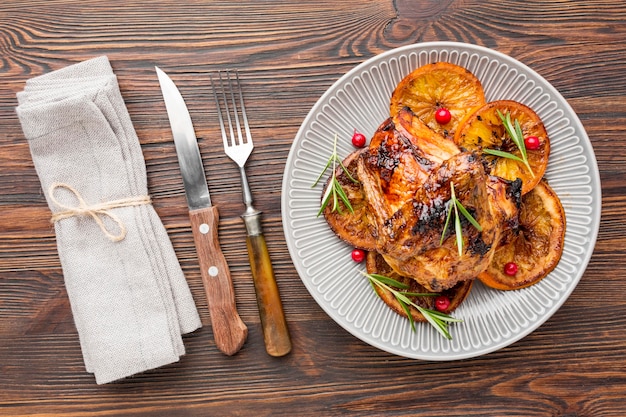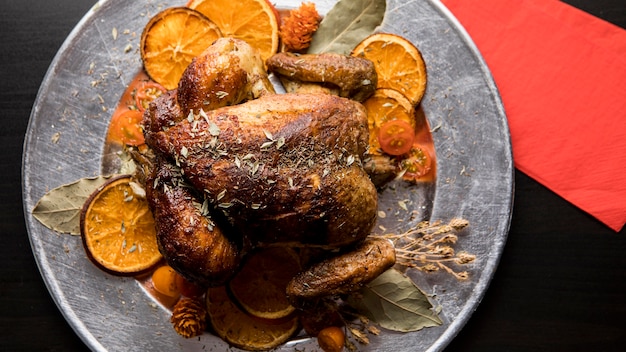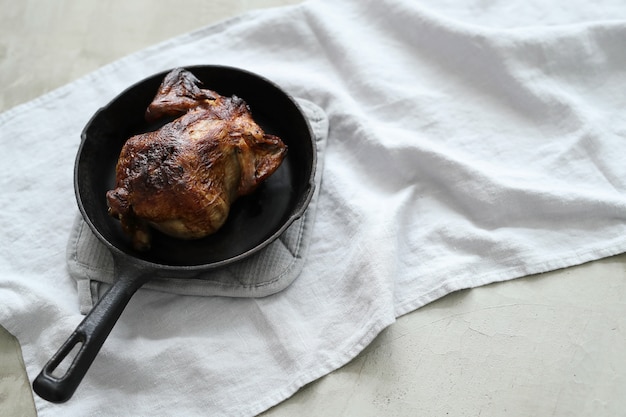There's something undeniably special about a roast duck, isn't there? It's a dish that evokes images of cozy Sunday lunches, festive gatherings, and memories of family and friends gathered around a beautifully laden table. But achieving that perfect crispy-skinned, succulent roast duck isn't always a walk in the park. I've had my fair share of roast duck disasters, but through trial and error, I've learned a thing or two.
This guide is a culmination of those experiences – a collection of tips, tricks, and techniques designed to help you conquer the art of roast duck. We'll delve into choosing the right bird, mastering the art of preparation, and navigating the roasting process itself. Along the way, I'll share some of my personal anecdotes and, of course, a few cheeky jokes. After all, a little laughter always makes the cooking experience more enjoyable, don't you think?
So, grab your apron, fire up the oven, and let's embark on this culinary adventure together!
(Part 1) Choosing the Right Duck

The journey to a perfect roast duck begins with selecting the right bird. This isn't a decision to be taken lightly! There are several factors to consider to ensure your chosen duck is worthy of its starring role.
Duck Sizes and Types
I've learned that a duck weighing between 1.5kg and 2kg is ideal for a family of four. Anything smaller, and you might find yourself wishing for more, and a larger bird can take forever to cook.
Now, when it comes to breeds, there's a whole world to explore! Each type boasts unique flavour profiles and textures. I personally favour Mallards and Pekins. Their rich, flavourful meat isn't overwhelming, and their skin tends to crisp up beautifully in the oven.
Fresh or Frozen?
This is a question that sparks heated debates in culinary circles. Personally, I always opt for fresh ducks whenever possible. The flavour is simply more intense, and the skin has a satisfyingly crisp texture. If you must go frozen, ensure you defrost it thoroughly in the refrigerator overnight before cooking. No rushing!
Checking for Quality
Always give your chosen duck a thorough inspection before committing to it. The skin should be smooth and free of any blemishes. Feel the legs; they should feel firm, not floppy. Give the breastbone a gentle press – it should be slightly springy. If you're buying a whole duck, you should be able to feel the backbone; it should be fairly flat.
(Part 2) Preparing the Duck

Now we're getting into the nitty-gritty – the preparation phase, where we set the stage for a truly delicious roast.
Patting Down the Duck
First, give that duck a good pat down with some kitchen paper. We want to remove any excess moisture, which will help the skin achieve that coveted crispness.
Scoring the Skin
Next, we're going to score the skin. This is a crucial step for unlocking that crispy exterior. Using a sharp knife, make small, shallow cuts across the duck's breast and legs. This allows the fat to render out more evenly during cooking, resulting in that beautiful golden-brown, crispy skin.
Salt and Pepper
A generous sprinkle of salt and pepper is all you need at this stage. Keep it simple; less is more!
(Part 3) Stuffing the Duck

Ah, stuffing – a culinary adventure in its own right! There's no single right or wrong way to stuff a duck, but I do have a few tried-and-true tips:
Traditional Stuffings
A classic bread-based stuffing is always a winner. You can add sausage meat, onions, herbs, and even a touch of dried fruit. Just remember, keep it from being too wet. A soggy stuffing will steam the duck instead of allowing the skin to crisp up.
Alternative Stuffings
If you're feeling adventurous, explore some exciting variations. I've been known to fill my ducks with a medley of wild rice, mushrooms, and chestnuts – a truly flavourful explosion!
No Stuffing? No Problem!
Don't feel pressured to stuff your duck if you'd prefer not to. A simple roast duck served alongside roasted vegetables is just as delicious, I assure you.
(Part 4) Roasting the Duck
Now we're at the heart of the matter – the roast itself! This is where we transform our carefully prepared duck into a culinary masterpiece.
Choosing the Right Oven
You need a good, hot oven to cook a duck. Aim for a temperature around 180 degrees Celsius or 350 degrees fahrenheit.
roasting time
This is where things get a little trickier. cooking times vary depending on the size of the duck and how well you want it cooked. A good rule of thumb is about 20-25 minutes per pound (or 450g).
The Importance of Basting
Basting is the secret to unlocking that perfect roast duck. As the duck cooks, spoon the rendered fat over the bird. This keeps it moist and helps the skin crisp up beautifully.
Resting Time
Once the duck is cooked, it's essential to let it rest for about 10-15 minutes before carving. This allows the juices to redistribute, ensuring that the meat stays moist and tender.
(Part 5) Serving the Roast Duck
Finally, the moment we've all been waiting for – serving time!
Carving the Duck
I've found that the easiest way to carve a duck is to start by removing the legs and thighs. Then, slice the breast meat into thin, even slices.
Accompaniments
The possibilities are endless when it comes to accompaniments. My personal favourites include roast potatoes, roasted vegetables (especially carrots and parsnips), and a simple gravy made from the pan juices.
Presentation
Don't be afraid to get creative with the presentation. Arrange the duck slices on a platter, surrounded by roasted vegetables. Add a splash of colour with some fresh herbs, and you've created a truly stunning centerpiece.
(Part 6) FAQs
I'm sure you've got a few questions, so let's address them head-on!
1. What if the skin isn’t crispy?
If your duck skin isn't as crispy as you'd like, you can always give it a quick blast under the grill for a few minutes. Just keep a watchful eye, as it can burn easily.
2. How do I know when the duck is cooked?
A meat thermometer is your best friend here. The duck is cooked when it reaches an internal temperature of 82 degrees Celsius (180 degrees Fahrenheit) in the thickest part of the thigh.
3. What can I do with the leftover duck?
Leftover duck is a culinary goldmine! It's delicious in salads, sandwiches, or even as the star of a flavorful duck curry.
4. Can I freeze roast duck?
Absolutely! Wrap it tightly in cling film and store it in the freezer for up to 3 months.
5. How do I get rid of the duck fat?
After the duck has cooked, you'll be left with a treasure trove of delicious duck fat. This can be used to cook potatoes, vegetables, or even make a decadent duck fat gravy.
(Part 7) My Favourite roast duck recipe
Now, I'm not one to brag, but I've perfected a roast duck recipe that's sure to impress.
Ingredients:
- 1 duck, about 1.5kg - 2kg
- 2 tbsp olive oil
- 1 large onion, chopped
- 2 carrots, chopped
- 2 celery sticks, chopped
- 1 tsp dried thyme
- 1/2 tsp salt
- 1/4 tsp black pepper
- 1 cup chicken stock
Instructions:
- Preheat your oven to 180 degrees Celsius (350 degrees Fahrenheit).
- Score the duck skin and pat it dry.
- Heat the olive oil in a large roasting pan over medium heat.
- Add the duck to the pan and cook for 5-7 minutes on each side, until golden brown.
- Remove the duck from the pan and set aside.
- Add the onion, carrots, celery, thyme, salt, and pepper to the pan and cook for 5-7 minutes, stirring occasionally.
- Return the duck to the pan and add the chicken stock.
- Roast for 1 hour and 45 minutes to 2 hours, basting the duck every 30 minutes.
- Let the duck rest for 10-15 minutes before carving.
Serve with your favourite accompaniments and enjoy!
(Part 8) Top Tips for Perfect Roast Duck
Before we bid adieu, let's wrap up with a few extra tips to elevate your roast duck to new heights:
Don’t Overcook it!
One of the most common mistakes is overcooking the duck. It's always better to err on the side of undercooked, as the meat will continue to cook slightly as it rests.
Use a Meat Thermometer
A meat thermometer is a kitchen essential. It removes any guesswork, ensuring your duck is cooked to perfection.
Don’t Be Afraid to Experiment
Roast duck is a blank canvas for your culinary creativity. Don't be afraid to explore different stuffings, sauces, and accompaniments to discover your favourite flavour combinations.
Enjoy the Process
Cooking a roast duck is a truly rewarding experience. Take your time, savor the process, and revel in the delicious aromas that will fill your kitchen.
And there you have it – my ultimate guide to cooking the perfect roast duck. I hope you find it informative and inspiring. Now go forth and create culinary magic!
Everyone is watching

Prime Rib Roast Cooking Time Chart: Per Pound Guide
Cooking TipsPrime rib roast. Just the name conjures images of lavish dinners, crackling fires, and hearty laughter. It’s ...

How Long to Bake Potatoes in the Oven (Perfect Every Time)
Cooking TipsBaked potatoes are a staple in my kitchen. They're incredibly versatile, delicious, and surprisingly easy to m...

Perfect Rice Every Time: The Ultimate Guide to Cooking Rice
Cooking TipsAs a self-proclaimed foodie, I've always been a bit obsessed with rice. It's the foundation of countless cuisi...

The Ultimate Guide to Cooking Asparagus: Tips, Techniques, and Recipes
Cooking TipsAsparagus. The mere mention of this spring delicacy conjures up images of vibrant green spears, crisp and burs...

Ultimate Guide to Cooking the Perfect Thanksgiving Turkey
Cooking TipsThanksgiving. Just the word conjures up images of overflowing tables laden with delicious food, the scent of r...
